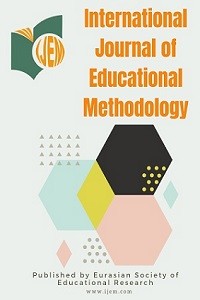Research Article
Year 2018,
Volume: 4 Issue: 1, 37 - 43, 01.02.2018
Abstract
References
- Barrows, H. S. (1996). Problem-Based Learning in Medicine and Beyond: A Brief Overview. New Direction for Teaching and Learning, 68, 3-12. doi: 10.1002/tl.37219966804.
- Beker, K. H., & Maunsaiyat, S. (2004). A comparison of students; achievement and attitudes between constructivist and traditional classroom environment in Thailand vocational electronics programs. Journal of Vocational Education Research, 29(2), 133-153. doi: 10.5328/JVER29.2.133.
- Blumberg, P. (2000). Evaluating the evidence that Problem-Based learners are self-directed learners: A review of the literature. In D. H. Evensen, & E. E. Hmelo (Eds.), Problem-Based Learning: A research perspective on learning interactions (pp. 199-226). Mahwah, NJ: Erlbaum.
- Carnine, D.W., Silbert, J., Kamenui, E.J., & Tarve, S.G. (2000). Direct Instruction Reading. Prentice Hall. Pp. 5-6; Traub, 1999).
- Choi, E., Lindquist, R., & Song Y. (2014). Effect of Problem-Based Learning vs. Traditional lecture on Korean nursing students’ critical thinking, problem-solving, and self-directed learning. Nurse Education Today, 34, 52-56. doi: 10.1016/j.nedt.2013.02.012.
- Guses, A., Dogar, C., & Gunesm K. (2015). A New Approach for Learning: Interactive Direct Teaching Based Constructivist Learning (IDTBCCL). Procedia-Social and Behavioral Sciences, 197, 2384-2389. doi.: 10.1016/j.sbspro.2015.07.296.
- Hattie, J. (2009). . London and New York: Routledge.
- Neo, M., & Neo, K.T.K. (2000). Multimedia Learning: Using multimedia as a platform for instruction and learning in higher education. Paper presented at the Multimedia University International Symposium on Information and Communication.
- Neo, M., & Neo, K.T.K. (2001). Innovative teaching: Using multimedia in a problem-based learning environment. Educational Technology & Society, 4(4), 19-31.
- Stockard, J. (2010). Improving elementary level mathematics achievement in a large urban district: The effects of Direct Instruction in the Baltimore City Public School System. Journal of Direct Instruction, 1-16.
- Tan, O. S. (2000). Thinking Skills, Creativity and Problem-Based Learning. Paper presented at the 2nd Asia Pacific Conference on Problem - Based Learning: Education a cross Disciplines, December 4-7, 2000, Singapore.
- Vinay, M., & Rassak, S. (2015). A technological Framework for Teaching-Learning Process of Computer Networks to Increase the Learning Habit. International Journal of Computer Applications, 117(4). doi: 10.5120/20539-2904
- Yusof, K. M., Hasan, S. A. H. S., Jamaludin, M. Z., & Harun, N. F. (2012). Cooperative Problem-Based Learning (CPBL): Framework for Integrating Cooperative Learning and Problem-Based Learning. Procedia-Social and Behavioral Sciences, 56, 223-232. doi: 10.1016/j.sbspro.2012.09.649
Students’ Feedback of mDPBL Approach and the Learning Impact towards Computer Networks Teaching and Learning
Abstract
This study presents students’ feedback and learning impact on design and development of a multimedia learning in Direct Problem-Based Learning approach (mDPBL) for Computer Networks in Dian Nuswantoro University, Indonesia. This study examined the usefulness, contents and navigation of the multimedia learning as well as learning impacts towards mDPBL approach which used. A total of 276 students who took Computer Networks subject from two different departments participated in this study of a quasi-experiment in year 2016. Two different ways of teaching, one the normal of teaching/traditional approach, another one using mDPBL approach of teaching. However, the purpose of this study, Analysis and report in this study only the feedback of the students participated in mDPBL group (n=136). Nearly all students have positive feedback of the multimedia learning especially usefulness, contents and navigation, and also they have positive feedback of the mDPBL teaching approach. While, the overall feedback towards mDPBL approach presented in the findings/results section.
References
- Barrows, H. S. (1996). Problem-Based Learning in Medicine and Beyond: A Brief Overview. New Direction for Teaching and Learning, 68, 3-12. doi: 10.1002/tl.37219966804.
- Beker, K. H., & Maunsaiyat, S. (2004). A comparison of students; achievement and attitudes between constructivist and traditional classroom environment in Thailand vocational electronics programs. Journal of Vocational Education Research, 29(2), 133-153. doi: 10.5328/JVER29.2.133.
- Blumberg, P. (2000). Evaluating the evidence that Problem-Based learners are self-directed learners: A review of the literature. In D. H. Evensen, & E. E. Hmelo (Eds.), Problem-Based Learning: A research perspective on learning interactions (pp. 199-226). Mahwah, NJ: Erlbaum.
- Carnine, D.W., Silbert, J., Kamenui, E.J., & Tarve, S.G. (2000). Direct Instruction Reading. Prentice Hall. Pp. 5-6; Traub, 1999).
- Choi, E., Lindquist, R., & Song Y. (2014). Effect of Problem-Based Learning vs. Traditional lecture on Korean nursing students’ critical thinking, problem-solving, and self-directed learning. Nurse Education Today, 34, 52-56. doi: 10.1016/j.nedt.2013.02.012.
- Guses, A., Dogar, C., & Gunesm K. (2015). A New Approach for Learning: Interactive Direct Teaching Based Constructivist Learning (IDTBCCL). Procedia-Social and Behavioral Sciences, 197, 2384-2389. doi.: 10.1016/j.sbspro.2015.07.296.
- Hattie, J. (2009). . London and New York: Routledge.
- Neo, M., & Neo, K.T.K. (2000). Multimedia Learning: Using multimedia as a platform for instruction and learning in higher education. Paper presented at the Multimedia University International Symposium on Information and Communication.
- Neo, M., & Neo, K.T.K. (2001). Innovative teaching: Using multimedia in a problem-based learning environment. Educational Technology & Society, 4(4), 19-31.
- Stockard, J. (2010). Improving elementary level mathematics achievement in a large urban district: The effects of Direct Instruction in the Baltimore City Public School System. Journal of Direct Instruction, 1-16.
- Tan, O. S. (2000). Thinking Skills, Creativity and Problem-Based Learning. Paper presented at the 2nd Asia Pacific Conference on Problem - Based Learning: Education a cross Disciplines, December 4-7, 2000, Singapore.
- Vinay, M., & Rassak, S. (2015). A technological Framework for Teaching-Learning Process of Computer Networks to Increase the Learning Habit. International Journal of Computer Applications, 117(4). doi: 10.5120/20539-2904
- Yusof, K. M., Hasan, S. A. H. S., Jamaludin, M. Z., & Harun, N. F. (2012). Cooperative Problem-Based Learning (CPBL): Framework for Integrating Cooperative Learning and Problem-Based Learning. Procedia-Social and Behavioral Sciences, 56, 223-232. doi: 10.1016/j.sbspro.2012.09.649
There are 13 citations in total.
Details
| Primary Language | English |
|---|---|
| Subjects | Studies on Education |
| Other ID | JA36FB45ZV |
| Journal Section | Research Article |
| Authors | |
| Publication Date | February 1, 2018 |
| Published in Issue | Year 2018 Volume: 4 Issue: 1 |

